Godairiki-san Rice Cake competition and yamabushi traditions
Source - http://heritageofjapan.wordpress.com/
 Rice-cake lifting contest in Kyoto (February 23, 2012)
Rice-cake lifting contest in Kyoto (February 23, 2012)
Contestants competed to lift and hold giant rice cakes for as long as they could at a Buddhist temple in Kyoto on Thursday.
71 people took part in the traditional event, aimed at fostering good health, at Daigoji Temple.
The men’s rice cake was150 kilograms, while the women’s weighed 90 kilograms.
Most contenders could not even pick up the cake, but a few managed to hold it amid cheers from spectators. A 28-year-old gardener won the men’s contest, holding the cake for 2 minutes and 58 seconds.A 40-year-old female police officer won the women’s category with a time of 8 minutes and 7 seconds.She got the rice cake as a prize and said that she will share it with her fellow officers and relatives.
Who are the Godairiki?
大威徳明王 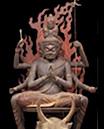
軍荼利明王 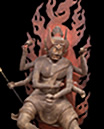
不動明王 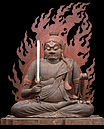
降三世明王 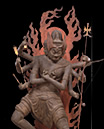
金剛夜叉明王 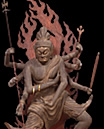
Lit. five great bodhisattvas of strength. These five bodhisattvas *bosatsu are described in Chapter 7 of the the Buddhist text NINNOUGYOU as protecting the lands of kings who uphold Buddhism, particularly through obedience to the Tripitaka or three divisions of the Buddhist canon or sutras. In the latter Amoghavajra (Jp: Fukuu ), they are referred to collectively as simply the bodhisattvas of the five directions, gohou bosatsu.
The NINNOUGYOU (generally considered to be an apocryphal work composed in China) was revered in Japan from the Nara period onwards as one of the three state-protecting sutras GOKOKU SANBUKYOU , and the cult of the godairiki bosatsu spread with the institutionalization of the ninnou-e , a practice based on the NINNOUGYOU. This ritual which aimed at protecting the country was first held in the tenth year of the reign of Empress Saimei (660). The ninnou-e was celebrated at the foot of Mt. Kouya in Jison-in (826) Wakayama prefecture, and then was revived, after a break (1108) in the Kondou, with the main image *honzon , for the ceremony being stored in Kitamuro-in.
A variation of the ninnou-e performed annually at Daigoji in Kyoto, is in fact called godairiki-san although it is strongly tinged with elements of the cult of the *godai myouou. The godairiki bosatsu are depicted in wrathful form, with Kongou seated on a lotus and the other four standing with one leg raised. All extant images date from the Heian period or later, and are related to the celebration of the ninnou-e. Early examples of the godairiki include the iconographic drawing of the *Ninnougyou mandara in the Spencer Collection in the New York Public Library and the set of five standing images in Akishinodera, Nara. A set of early line drawings *hakubyou is preserved at Fugen-in in Mt. Kouya. Polychrome depictions include a single-scroll representation kept at Kitamuro-in and a set originally of five hanging scrolls thought to date from the late Heian period and now kept at Yuushi Hachimankou juuhakkain both in Mt. Kouya. Two scrolls of the latter set were lost in a fire in 1888, and the remaining three (Kongouku, Ryuuoku and Muijuurikiku) have been designated national treasures. Source: JAANUS godairiki bosatsu 五大力菩薩
The Godairiki cult appears to have been promoted by the yamabushi ascetic monks as Godairiki-san worship and rituals are promoted at Junteido Temple, and other sub-temples of Shogoin-Monzeki, which also hold an annual event called Godairiki-san which celebrates the worship of the five bosatsu Buddha statues on February 23rd.
The Godairiki-san worship also has a history that goes back a thousand years to the establishment of the Daigoji Temple in Nara. During the Edo period, the Tokugawa shogunate permitted the practice of Shugendo (the mountain asceticism, also called Yamabushi) in Sanboin from Rigen Daishi (Shobo). As the head priest Koken of Daigoji entered the Omine mountain in Nara, the Daigo tradition became increasingly associated with Shugendo more and more. To commemorate this tradition, the event called Hanaku nyubu shugyo (Practice to enter the Omine mountain to offer flowers) is held by the head priest of Sanboin.
During the Godairiki-san Ninnoo-e ceremony, the priests ennumerate the virtues of Godai-myou and pray for the stability of the nation and prosperity of people. More than thirty thousand people visit this event annually. Worshipers may purchase “Godairiki Mie”, an amulet to prevent from the unfortune such as theft and robbery.
Before the ”Godairiki-san” or Festival of the Five Powerful Deities at the Daigo-ji Temple in Fushimi Ward, Kyoto, a competition called “mochi age riki hoonoo” is held whereby people test their strength by lifting the heavy kagami-mochi rice cakes, one in white and one in red.
The giant rice cakes used in the Hercules contest are showcased from February 10 at two locations, including JR Kyoto Station plaza in Shimogyo Ward. The Godaiji temple holds the display of rice cakes to publicize its annual memorial service held on February 23. On the first day of display, red-and-white two-tiered Kagami-mochi, with a diameter of 80 centimeters and weighing 150 kilograms, are placed in the lobby of a hotel near the station, as well as in the station plaza.
13 Buddhist monks dressed as mountain priests stand before the Kagami-mochi and blow conch-shell horns and read Buddhist sutras aloud in the ensoulment ceremony as they prayed for the happiness of local residents and tourists.
Kagami-mochi rice cakes are offerings to the gods, in the kamidana, for Toshigami, the god of the new year, to bring good luck and prosperity in the new year. They are considered auspicious foods in ancient times placed in various places around the house, although they are today mostly restricted to the tokonoma and Shinto altar areas. They are said have originated from its resemblance to an old-fashioned kind of round copper mirror, which also had a religious significance. The spiritual symbolism for the rice cakes varies from the ‘spirit’ of the rice plant being found in the mochi, to it being a strength-giving food, to its disc-shape symbolizing the going and coming years, ”yin” and “yang”, or the moon and the sun. The “daidai” layers means “generations”, and is said to symbolize the continuation of a family from generation to generation. In the context of the giant kagami-mochi rice-cake lifting competitions, and wishes for strength, the most obvious symbolism is that rice-cakes are storehouses of energy and strength!
As to the origins of rice cakes, Wikipedia suggests that its origins may be traced to indigenous Jomon Period flour cakes or to the Korean tteok rice cake that dates to the Bronze Age. However, it is more likely that the origin of the rice cake offering is connected to the Southeast Asian (China) practice of offering Taoist rice cake offerings to their deities (see photo below). Specific cultural similarities in the sacred practices can be seen in those practised during the nine-day Nine Emperor Gods Festival, a Taoist celebration beginning on the eve of 9th lunar month of the Chinese calendar, observed primarily in Southeast Asian countries like Thailand, Myanmar, Singapore, Malaysia, and also the Riau Islands. The way that the Kagami-mochi is displayed is closer however to the way that nian-gao sticky cake is offered to the Chinese kitchen god. Traditional says nian-gao is offered to the Kitchen god, Yu Huang Da Di (i.e. on the Jade Emperor’s birthday, on the 9th day after the 1st moon of the lunar calendar), or according to a 3,000 year old legend to Emperor Wu.
VIDEO = http://www.youtube.com/watch?v=mGaJkyTgVZ4http://www.youtube.com/watch?v=mGaJkyTgVZ4